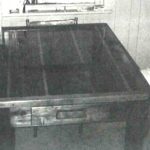
By Joe Parker
Use seasoned lumber
Even though your lumber is dry, the environmental conditions in many homes will cause dimensional changes in the piece after it is built. A good way to avoid this problem is to season the lumber in the house for a couple of weeks prior to building the piece. Do not season material in a basement or garage workshop unless you intend to keep the piece there after completion.
Before seasoning, machine the lumber close to the necessary dimension. For instance, if you have 2″ x 12″ stock, and plan to resaw it to 2″ x 3″ and laminate a table top, resaw before seasoning. Also be sure to machine and season more material than you think you will need, in case some of it twists or warps during the seasoning process and is unusable.
Many flooring contractors and cabinet makers season lumber in the room where it will be installed. This is because of the different temperature and humidity levels in the various rooms of a house.
Machining and surface prep for bonding
When machining lumber with high-speed tools (joiner, planer, router, etc.), watch for glazing or burnishing of the lumber surface, especially when working with hardwoods. A dull saw blade can also burnish wood. If the mating surfaces are glazed over or burnished, the adhesive will not penetrate the surface. This can cause failure in the joint.
If you suspect that wood is burnished, test the surface with a drop of water. If it stands on the surface as a bead and does not soak into the wood, the epoxy can not soak in either. Sand the surface with 60 or 80-grit sandpaper and put another drop of water on the wood. If the water spreads out and soaks in, the surface is ready for bonding.
Two step bonding
We recommend using the two step bonding technique for gluing wooden parts together. The low-viscosity epoxy mixture will soak into the wood for good adhesion. The thickened mixture will bridge any gaps in the joint and prevent all of the epoxy from being squeezed out of the joint.
Wet-out coat
Apply a straight resin and hardener mixture (without fillers) to the surfaces to be joined. This is called wetting out the surface. The resin and hardener mixture may be applied with a disposable brush for small or tight areas, or a foam roller for larger areas. A large horizontal area can also be wet out by using a plastic squeegee to spread the resin and hardener mixture evenly over the surface.
Apply thickened epoxy
Modify the resin and hardener mixture by stirring in the appropriate filler until the mixture is thick enough to bridge any gaps between the mating surfaces and prevent resin-starved joints. Apply an even coat of thickened mixture to one of the surfaces to be joined. Thickened epoxy can be applied immediately over the wet-out surface or any time before the wet-out reaches its final cure. Apply enough of the mixture so that a small amount will squeeze out when the surfaces are joined together with a force equivalent to a firm hand grip.
Glue line coloring
Sometimes a glue line will be obtrusive. With a little practice, you can hide the glue line almost completely. Some try to color the epoxy by adding sanding dust from the wood. However, sanding dust will usually make a mixture that is too dark to match, and the wood dust will float in the epoxy. This causes the viscosity of the mixture to change from the top of the mixing pot to the bottom.
A better alternative is to thicken the epoxy with 406 Colloidal Silica, which makes a creamy white mixture. Then add just enough sanding dust or tempera paint pigment to create the desired color.






